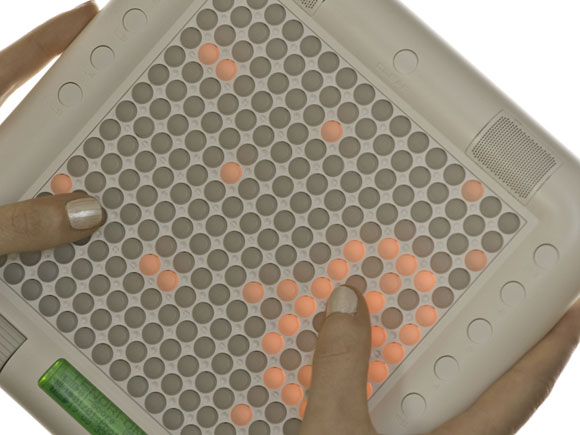The Tenori-On, the grid-based musical instrument with whimsical sequenced lights created by Toshio Iwai, has been gradually becoming more affordable. The original model, complete with its rounded metal case, has already been cut to US$999 here in North America. Now, Yamaha announces that it is making an “Orange” version which also slices costs. A plastic case stands in for the metal one, the lights are orange instead of white, and lights appear only on one side. Yamaha says this is for “home use” — that is, you don’t need the device lighting up on the other side if no one’s watching you. Unfortunately, by removing this novelty and eliminating the Tenori-On’s fantastic battery power option, I suspect Yamaha may also be slicing out some of the appeal of the device.
In the UK, MusicRadar reports the device will ship at £649. Here in the US, I’ve confirmed with distributor Keyfax that the price will be $699. Now, unlike other recent grid rivals (Launchpad, APC40, Ohm64) and the monome, the Tenori-On is capable of making sound. But I’d be inclined to either spend the extra $400 and make it light up on both sides and use it in bed sans wires or skip the idea altogether. I’m curious to know if others feel the same way.
MusicRadar also gets the scoop from Yamaha in the UK that a firmware upgrade is due for the Tenori-On fixing its somewhat problematic MIDI sync:
We’re told that this will address a number of areas, including syncing of the Tenori-on to DAWs and also the MIDI sync implementation.
Yamaha announces ‘more affordable’ Tenori-on Orange [MusicRadar]
Tenori-On product page [Yamaha worldwide]
Tenori-On USA [Keyfax]
It’s worth poking around the store if you do own a Tenori-On. Those brave early adopters can now make the instrument a pretty practical addition to a live set, with a nice case, stand, and (finally) stand mic stand adapter to feature it in your sets. And in another nod to the design, the Tenori-On recently entered the permanent collection of the Museum of Modern Art in New York.
In the meantime, I’m still curious to see if someone mashes up a synth engine and monome to make a computer-less monome.
